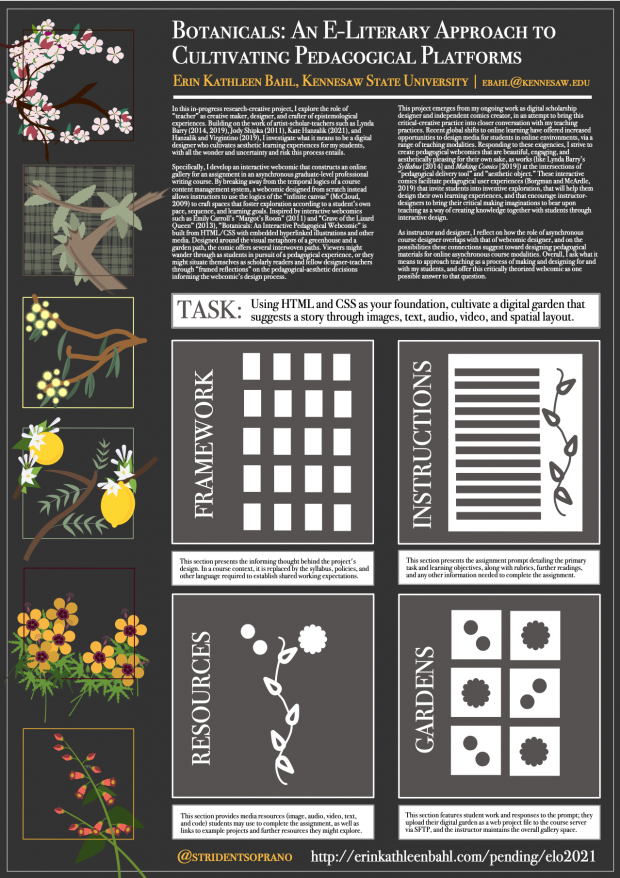Botanicals: An E-Literary Approach to Cultivating Pedagogical Platforms
This poster presentation discusses a forthcoming critical making project (part of The Digital Review's special issue on "Critical Making, Critical Design") at the intersections of electronic literature and asynchronous online pedagogy. In this research-creative project, I explore the role of “teacher” as creative maker, designer, and crafter of epistemological experiences. Building on the work of artist-scholar-teachers such as Lynda Barry (2014, 2019), Jody Shipka (2011), Kate Hanzalik (2021), and Hanzalik and Virgintino (2019), I investigate what it means to be a digital designer who cultivates aesthetic learning experiences for my students, with all the wonder, uncertainty, and risk this process entails.
In the poster session lightning talk, I introduce the pedagogical webcomic (described below) and the theory and design practices behind it. I then compare the affordances and constraints for “instructor as maker” between two pedagogical platforms: a designer-controlled platform created via the “infinite canvas” (McCloud, 2009) of a website in HTML/CSS; and D2L Brightspace, the content management system used at my university. Overall, I ask audience members to consider how we can bring our work as makers and scholars of electronic literature to explore new horizons for engaging, experiential course delivery methods via online platforms.
“Botanicals” is an interactive webcomic that reimagines an online platform for an asynchronous professional writing course informed by e-literary design. By breaking away from the temporal logics of a course content management system, a webcomic designed from scratch instead allows instructors to use the logics of the “infinite canvas” to craft spaces that foster exploration according to a student’s own pace, sequence, and learning goals. Inspired by interactive webcomics such as Emily Carroll’s “Margot’s Room” (2011) and “Grave of the Lizard Queen” (2013), “Botanicals: An Interactive Pedagogical Webcomic” is built from HTML/CSS with embedded hyperlinked illustrations and other media. Designed around the visual metaphors of a greenhouse and a garden path, the comic offers two interwoven “tracks.” One track addresses students “wandering through” the comic in pursuit of a pedagogical experience, and another track addresses scholarly readers and fellow designer-teachers with “framed reflections” on the pedagogical-aesthetic decisions informing the webcomic’s design process.
This project emerges from my ongoing work as digital scholarship designer and independent comics creator, in an attempt to bring this critical-creative practice into closer conversation with my teaching practices. Recent global shifts to online learning have offered increased opportunities to design media for students in online environments, via a range of teaching modalities. Responding to these exigencies, I strive to create pedagogical webcomics that are beautiful, engaging, and aesthetically pleasing for their own sake, as works (like Barry’s Syllabus [2014] and Making Comics [2019]) at the intersections of “pedagogical delivery tool” and “aesthetic object.” These interactive comics facilitate pedagogical user experiences (Borgman and McArdle, 2019; Borgman and McArdle, 2021) that invite students into inventive exploration, that will help them design their own learning experiences, and that encourage instructor-designers to bring their critical making imaginations to bear upon teaching as a way of creating knowledge together with students through interactive design.


